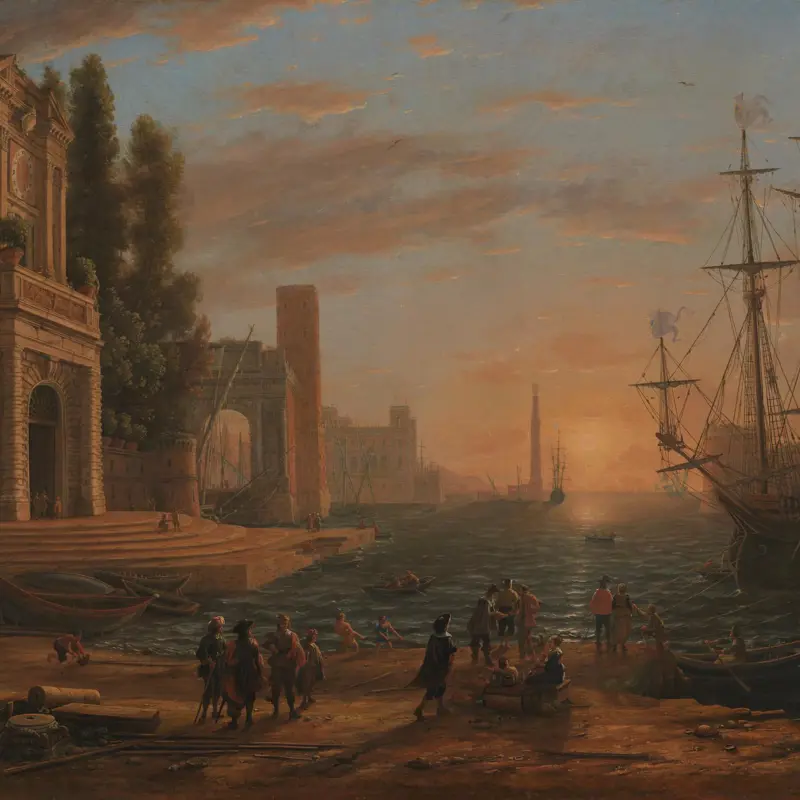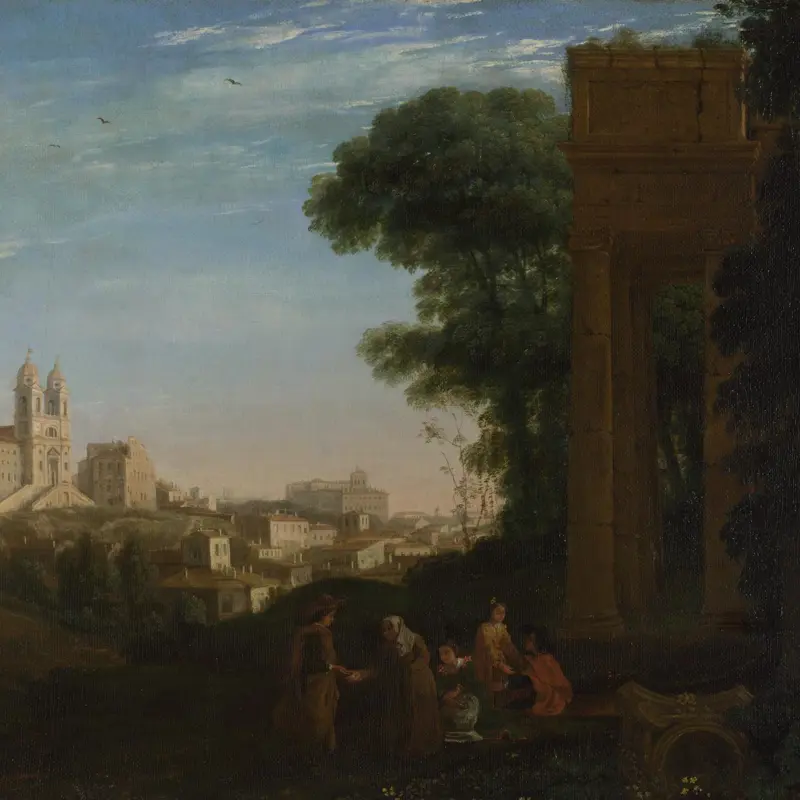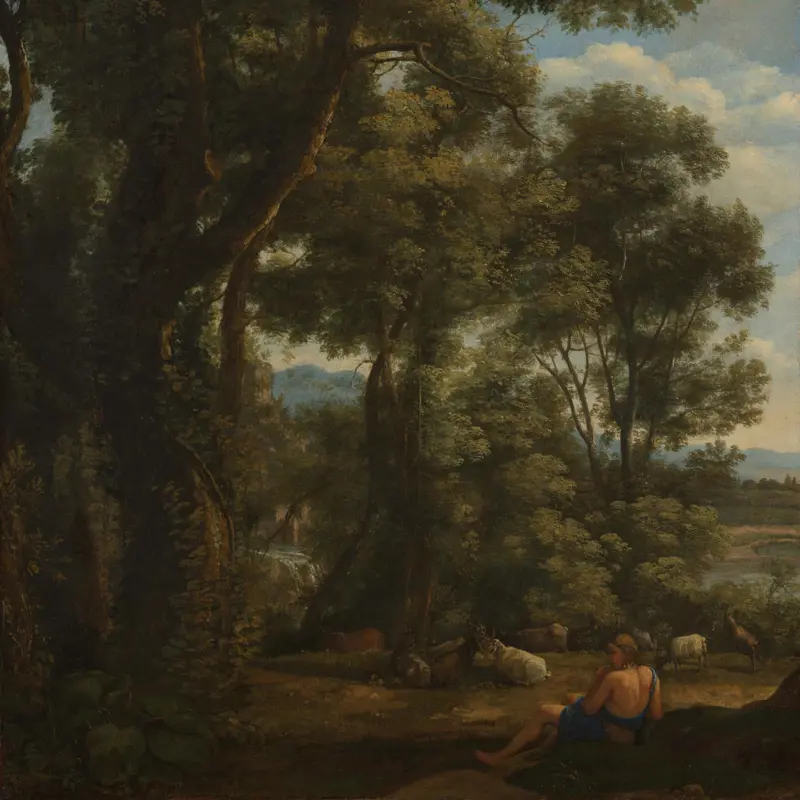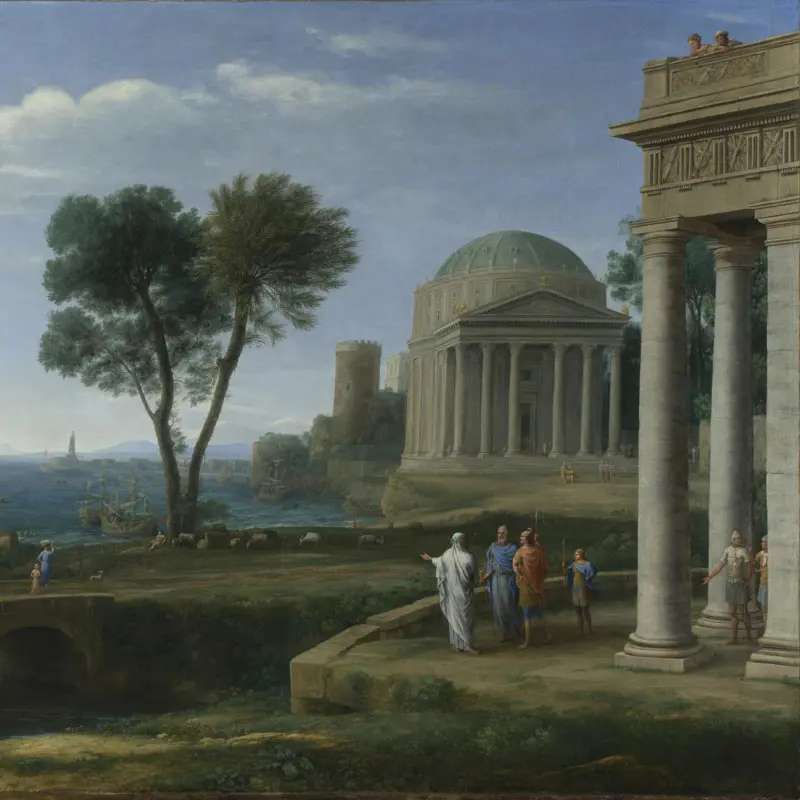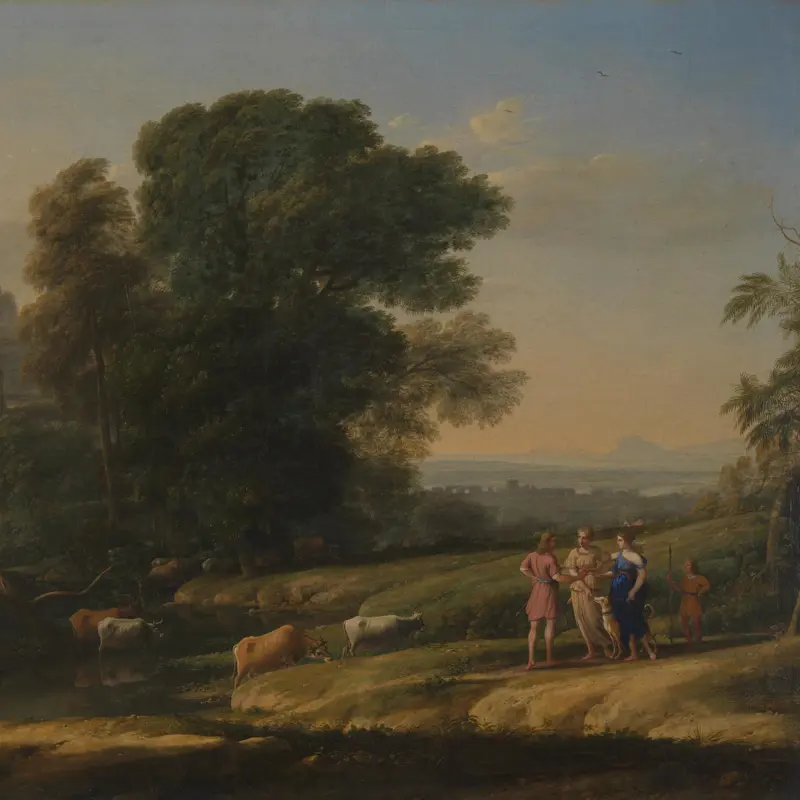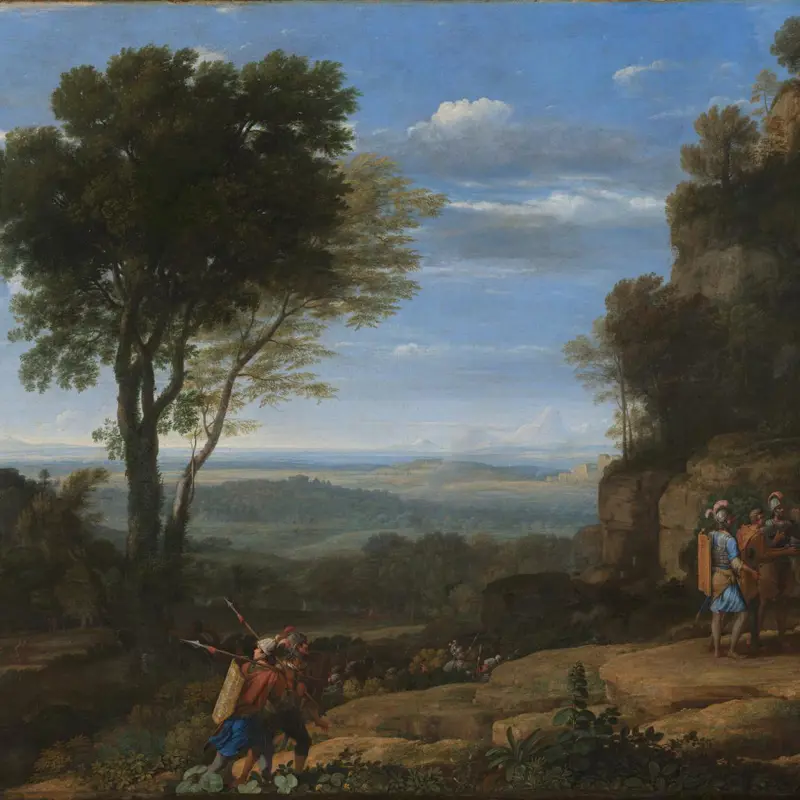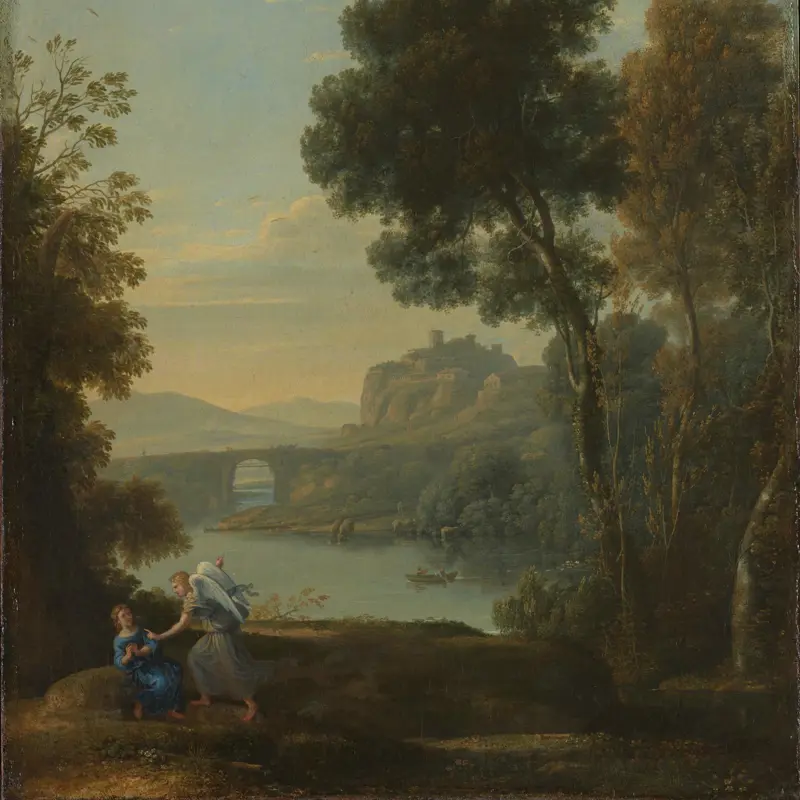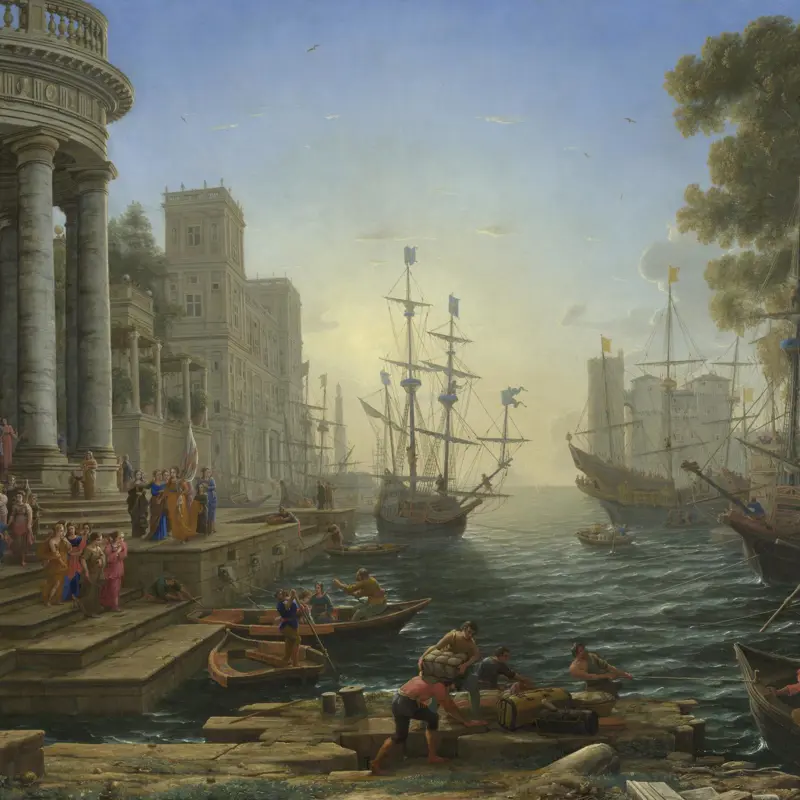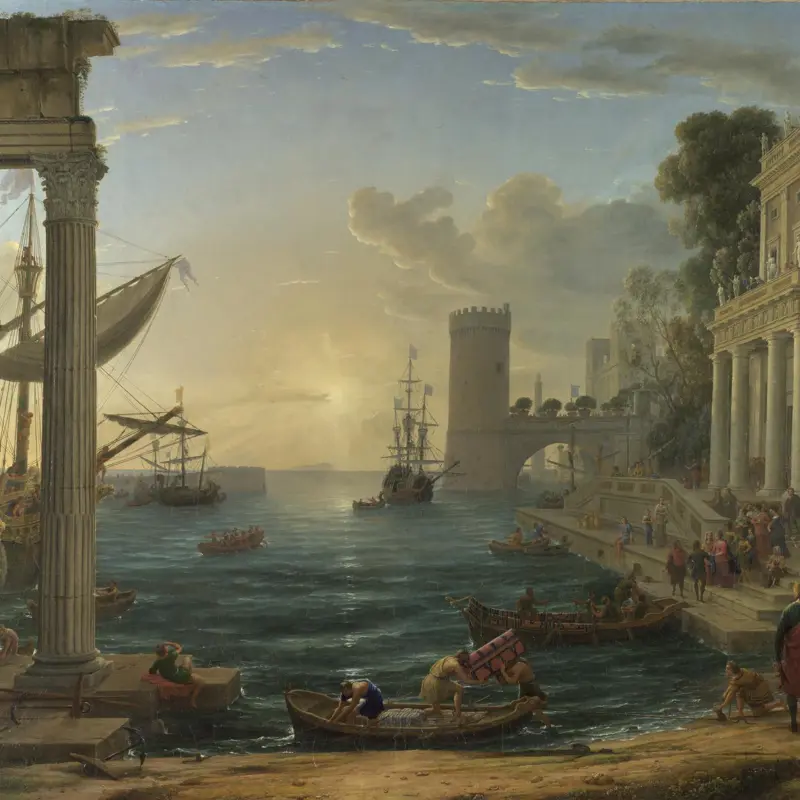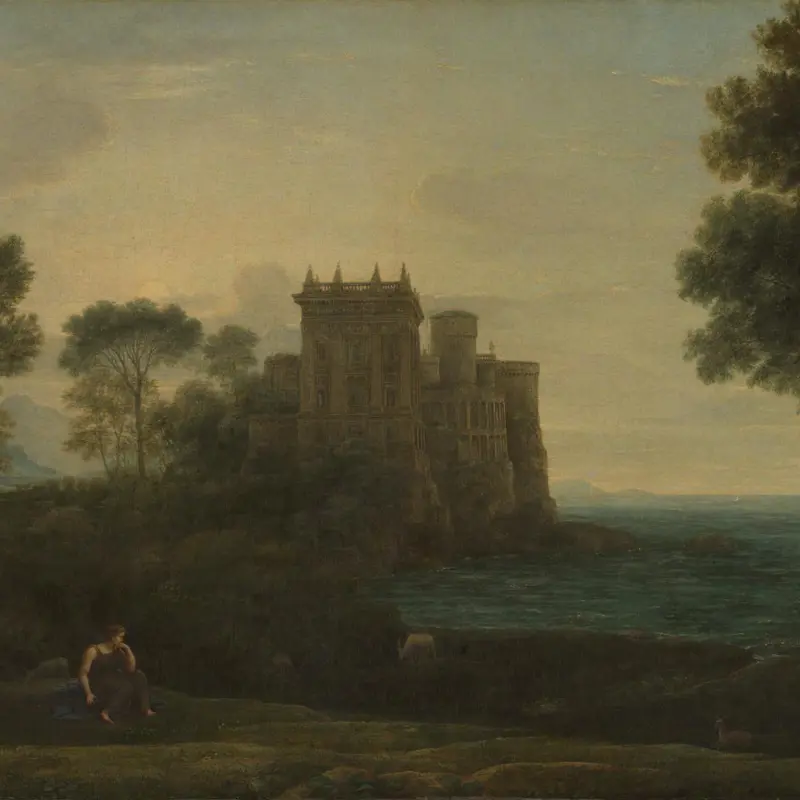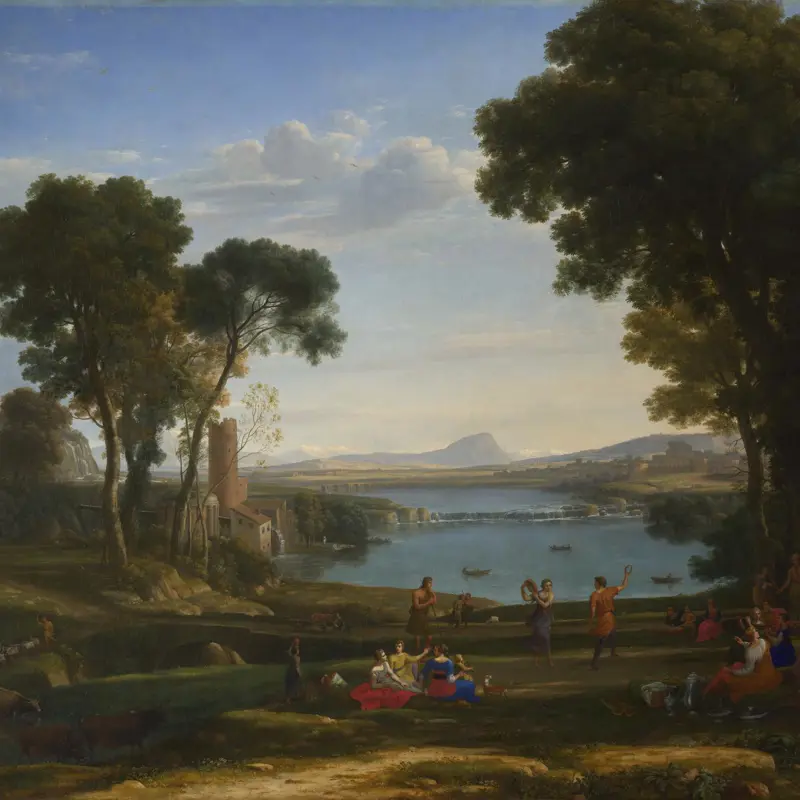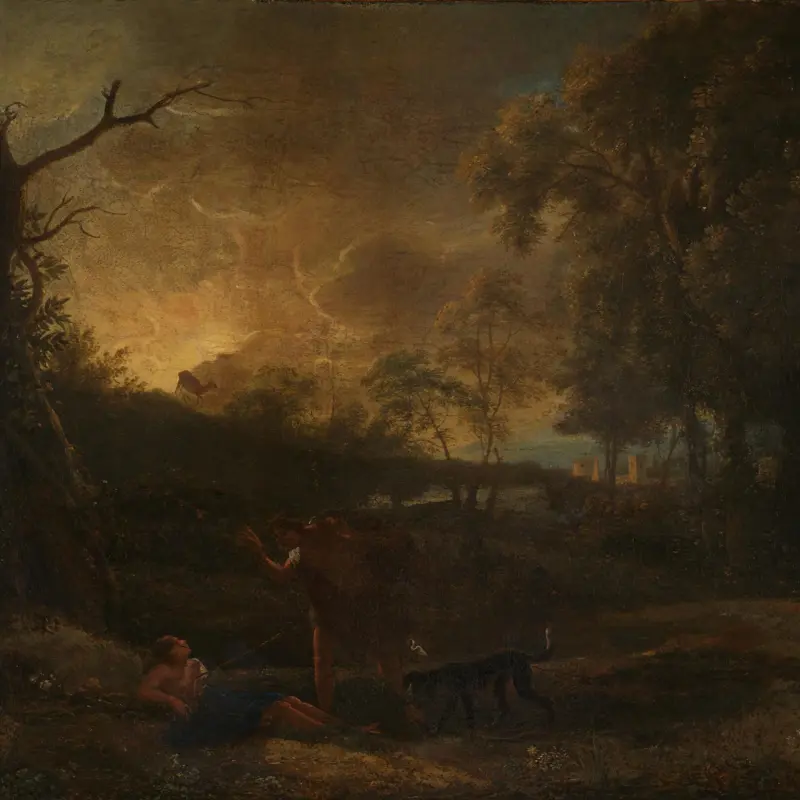Claude, 'Landscape with Narcissus and Echo', 1644
About the work
Overview
Claude takes the subject of this painting from Ovid’s Metamorphoses. The nymph Echo is in love with the beautiful youth Narcissus, who rejects her. In Claude’s painting, the goddess Nemesis punishes Narcissus by making him fall in love with his own reflection in a pool of water.
The castle in the background is not mentioned in Ovid’s story, and this is probably imaginary or based on ruins in the countryside near Rome, where Claude spent most of his life. Two nymphs hide in nearby trees: the lower nymph is probably Echo, who according to the story dies leaving only her voice. The nymph reclining at the bottom of the painting was originally partially covered with a blue robe, but has been repainted as nude. The reason for the change in her appearance remains unknown – this could be the work of Claude himself or a later artist. This figure often appears in paintings as a water nymph: she rests one arm on an urn and a gentle stream flows out of it.
Key facts
Details
- Full title
- Landscape with Narcissus and Echo
- Artist
- Claude
- Artist dates
- 1604/5? - 1682
- Date made
- 1644
- Medium and support
- oil on canvas
- Dimensions
- 94.6 × 118.7 cm
- Inscription summary
- Signed; Dated
- Acquisition credit
- Presented by Sir George Beaumont, 1826
- Inventory number
- NG19
- Location
- Not on display
- Collection
- Main Collection
- Previous owners
Provenance
Additional information
Text extracted from the ‘Provenance’ section of the catalogue entry in Humphrey Wine, ‘National Gallery Catalogues: The Seventeenth Century French Paintings’, London 2001; for further information, see the full catalogue entry.
Exhibition history
-
2012Turner Inspired: In the Light of ClaudeThe National Gallery (London)14 March 2012 - 5 June 2012
Bibliography
-
1790Christie's, A Catalogue of a Capital, Valuable, and Well-Chosen Collection of Italian, French, Flemish and Dutch Pictures, by the Most Esteemed Masters, the Whole in the Highest Preservation. Amongst the Above… also a Superbe and Beautiful Landscape by Claude Lorrain. Late the Property of Peter Delme Esq., London, 13 February 1790
-
1829
J. Smith, A Catalogue Raisonné of the Works of the Most Eminent Dutch, Flemish, and French Painters: In Which is Included a Short Biographical Notice of the Artists, with a Copious Description of Their Principal Pictures […], 9 vols, London 1829-1842
-
1884Mme Pattison, Claude Lorrain, sa vie et ses oeuvres, Paris 1884
-
1903J. Ruskin, Modern Painters, eds E.T. Cook and A. Wedderburn, The Works of John Ruskin, 39 vols, London 1903
-
1946Martin Davies, National Gallery Catalogues: French School, London 1946
-
1953O. Kurz, 'Huius Nympha Loci. A Pseudo-Classical Inscription and a Drawing by Dürer', Journal of the Warburg and Courtauld Institutes, XVI, 1953, pp. 171-7
-
1956Manchester City Art Gallery, John Constable, 1776-1837 (exh. cat. Manchester City Art Gallery, 26 April - 3 June 1956), Manchester 1956
-
1957Martin Davies, National Gallery Catalogues: French School, 2nd edn (revised), London 1957
-
1961M. Röthlisberger, Claude Lorrain: The Paintings, London 1961
-
1961Montreal Museum of Fine Arts, Héritage de France, French Painting 1610-1760 (exh. cat. Montreal Museum of Arts etc, 6 October - 6 November 1961; Musée de la Province de Quebec, 16 November - 16 December 1961; National Gallery of Canada, 4 January - 4 February 1962; Art Gallery of Ontario, 16 February - 18 March 1962), Montreal 1961
-
1968M. Röthlisberger, Claude Lorrain: The Drawings, London 1968
-
1975M. Röthlisberger, L'opera completa di Claude Lorrain, Milan 1975
-
1975E.B. MacDougall, 'The Sleeping Nymph: Origins of a Humanist Fountain', Art Bulletin, 1975
-
1978A. Macintyre and K. Garlick (eds), The Diary of Joseph Farington, vol. 5, New Haven 1978-1984
-
1978M. Kitson, Claude Lorrain: Liber Veritatis, London 1978
-
1982N.L. Pressly, 'Guy Head and His Echo Flying from Narcissus: A British Artist in Rome in the 1790's', Bulletin of the Detroit Institute of Arts, 1982, pp. 68-79
-
1982H.D. Russell, Claude Lorrain 1600-1682 (exh. cat. National Gallery of Art, Washington, 17 October 1982 - 2 February 1983), Washington 1982
-
1988D. Davies and L. Trenchs, Noble and Patriotic: The Beaumont Gift 1828, (exh. cat. The National Gallery, 3 February - 3 May 1988), London 1988
-
1989H. Langdon, Claude Lorrain, Oxford 1989
-
1992C.B. Bailey, The Loves of the Gods: Mythological Painting from Watteau to David (exh. cat. Galeries Nationales du Grand Palais, 15 October 1991 - 6 January 1992; Philadelphia Museum of Art, 23 February - 26 April 1992; Kimbell Art Museum, 23 May - 2 August 1992), New York 1992
-
1992H. Wine and O. Koester, Fransk Guldalder: Poussin and Claude and French Painting of the Seventeenth Century, (exh. cat. Statens Museum for Kunst, 29 February - 3 May 1992), Copenhagen 1992
-
1993D. Succhi and A. Delneri, Marco Ricci e il paesaggio veneto del Settecento (exh. cat. Palazzo Crepadona, 15 May - 22 August 1993), Milan 1993
-
1994H. Wine, Claude: The Poetic Landscape (exh. cat. The National Gallery, London, 26 January - 10 April 1994), London 1994
-
1996H. Langdon, 'The Imaginative Geographies of Claude Lorrain', in C. Chard and H. Langdon (eds), Transports: Travel, Pleasure, and Imaginative Geography, 1660-1830, New Haven 1996, pp. 151-78
-
1999G. Bergmann, Claude Lorrain: Das Leuchten der Landschaft, München 1999
-
2001H. Wine, National Gallery Catalogues: The Seventeenth Century French Paintings, London 2001
-
2001
C. Baker and T. Henry, The National Gallery: Complete Illustrated Catalogue, London 2001
-
2002M.L. Evans, 'A More Lasting Remembrance: Constable's Paintings of "Dedham Vale from the Coombs" and Claude's "Landscape with Hagar and the Angel"', British Art Journal, III/3, 2002, pp. 43-7
-
2002C. Pace, 'The Golden Age: The First and Last Days of Mankind: Claude Lorrain and Classical Pastoral, with Special Emphasis on Themes from Ovid's Metamorphoses', Artibus et historiae, XXIII/46, 2002, pp. 127-57
-
2003C. Pace, 'Collecting French Seventeenth-Century Paintings for the Nation', Art History, XXVI/2, 2003, pp. 281-315
-
2003S. Studdard and A. Sturgis, Paradise: A National Gallery Touring Exhibition (exh. cat. Bristol City Museum and Art Gallery, 18 January - 30 March 2003; Laing Art Gallery, 12 April - 29 June 2003; The National Gallery, London, 10 July - 28 September 2003), Bristol 2003
-
2005Andrew Wyld, Watercolours and Drawings: The Annual Exhibition (exh. cat. W/S Fine Art Ltd, 29 June - 22 July 2005), London 2005
About this record
If you know more about this work or have spotted an error, please contact us. Please note that exhibition histories are listed from 2009 onwards. Bibliographies may not be complete; more comprehensive information is available in the National Gallery Library.

